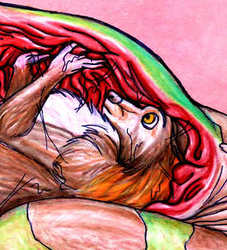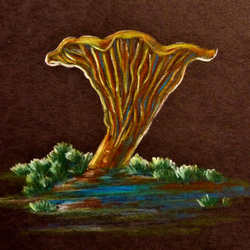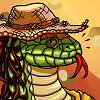Sign In
CloseMushroom Guidesheet 7--Common Suillus Species by SpiderMilkshake (critique requested)
Suillus is a genus of Boletoid mushrooms which are mycorhizal with various conifer species, such as pine, hemlock, spruce and larch. They are known as fantastic edibles, relatively easy to come by and identify, with dozens of species to choose from. Here's a summary of how to find and identify three of the most common species collected for food in North America.
Suillus americanus identification traits:
-The "Chicken Fat Mushroom" pairs most often with white pine and is a bright, "chicken-fat" yellow on all parts.
-When young and fresh, the stem and pore surface, sometimes also the cap, will exude a greasy substance much like chicken fat.
-Cap will nearly always be greasy or tacky, usually about 2 inches across average size with a proportionally skinny stem.
The Chicken Fat Mushroom is highly praised as an edible and is native to the eastern US and Canada. Look under white pine trees beginning in June, the day after rainfalls. When conditions are right, dozens are known to fruit from single organisms.
Suillus granulatus identification traits:
-A broadly-partnering species superficially similar to the related Jersey Cow Bolete, Suillus bovinus.
-Cap is brown, slimy to greasy or tacky depending on humidity. May be plain or have some slight darker patches or "scales".
-Stem near the pore surface will have tiny, easily brushed-aside "granules" attached. Fresh specimens have a higher chance of having their granulated stem intact.
-Grows with a variety of pine species, including two-needle and three-needle species. May also appear with hemlocks.
Granulated Boletes are the most common Suillus growing in late summer and autumn. This is handy, as they can fruit in the hundreds and are considered a AA+ grade edible, with tender flesh and a savory flavor. I have several in m' fridge currently as the pine trees nearby are producing a continuing series of fruitings with every rain.
Suillus spraguei/pictus identification traits:
-A beautiful and colorful Suillus, growing most often with red pines, sometimes with hemlocks and introduced Scots pines.
-Cap is yellow in underlying color, with thick covering of reddish scales or fibrils that spread further apart as the cap opens.
-This species displays a partial veil, delicate and membranous, over the lemon-yellow pores when young. As the mushroom matures this veil tears and some remnants will be left on the cap edge and stem.
-Flesh, when cut, stains slightly reddish. This stain fades back to yellowish color over time.
The Painted Bolete is one of the most visually impressive Suillus. It doesn't usually fruit in large numbers, but including a few in your dish can be worthwhile when they are numerous. Like cilantro, this mushroom species can taste wildly different (good or bad) depending on the person--be sure to taste a small sample before deciding if this species is in your list of edibles!
Some notes to basic Suillus genus identification:
-Suillus are mushrooms best known for the gourmet Slippery Jack, Suillus luteus, which displays many features that define the genus. Partial veils of a membranous substance are common in many species as are a squat, ground-hugging stature, yellowish-to-cream pore surfaces that are easily peeled away from the cap, greasy caps whose cuticles are also conveniently easy to peel away, and delicate tender cap tissue which is generally non-staining and pale in color. Suillus do not grow from wood or dung but form underground symbiosis with conifer trees--they are growing directly from the forest soil and commonly form "fairy rings" or crescent shapes around their partner trees.
Notes on prepping Suillus for cooking:
-Some people report the greasy cap cuticle and pore layers of Suillus mushrooms can cause gastrointestinal distress in those with pre-existing digestive conditions. For safe handling and cleaning of these species, it's recommended you peel the cap skin and pore surface from the caps before wiping the mushroom clean with a damp cloth and allowing to air dry a few moments prior to cooking.
-Never eat any mushroom that you cannot identify with confidence. If you are unsure, consult an expert or simply choose caution and eat something else. XD Better safe than sorry--toxic boletoids are extremely rare but they do exist.
^u^ I really enjoy some beer-battered fried Suillus, roasted Suillus with meat and veggies, Suillus browned and then added to wild mushroom soups... they're excellent little shrooms for eating, 99% foolproof and easy to learn how to avoid that 1% of error. XD
Submission Information
- Views:
- 521
- Comments:
- 0
- Favorites:
- 3
- Rating:
- General
- Category:
- Visual / Traditional




